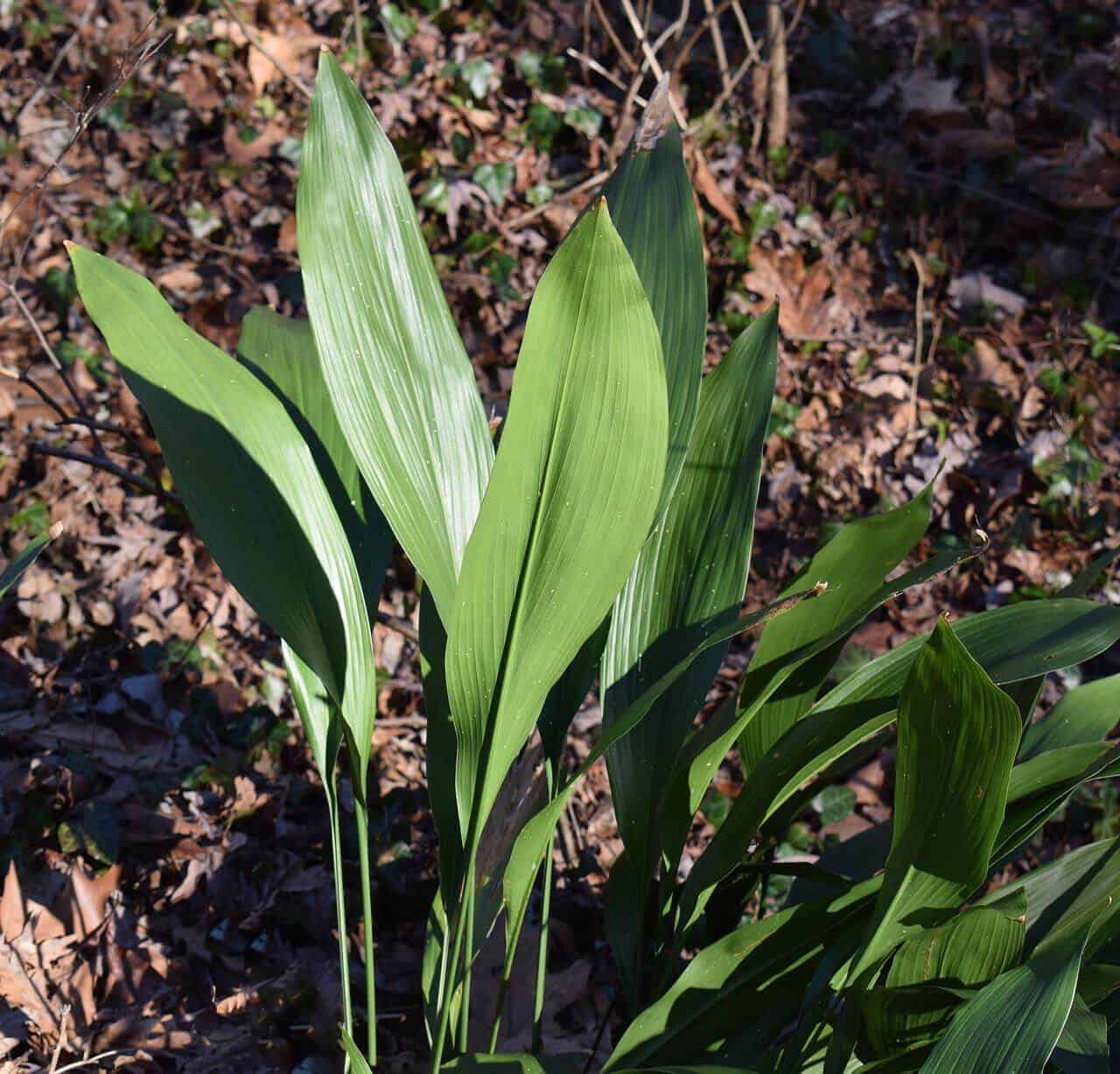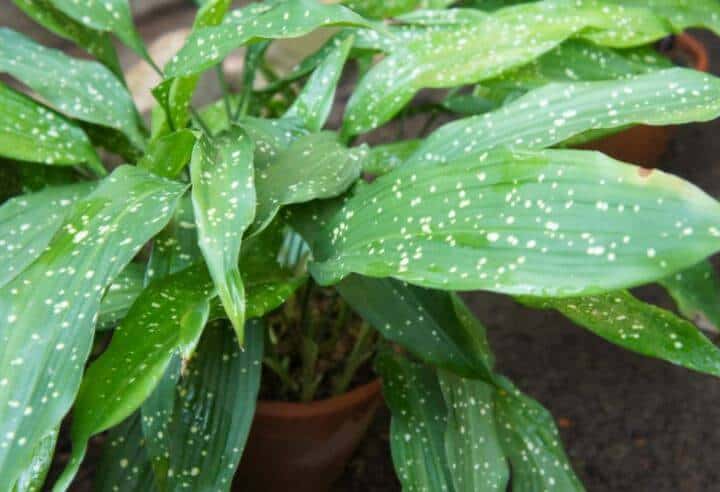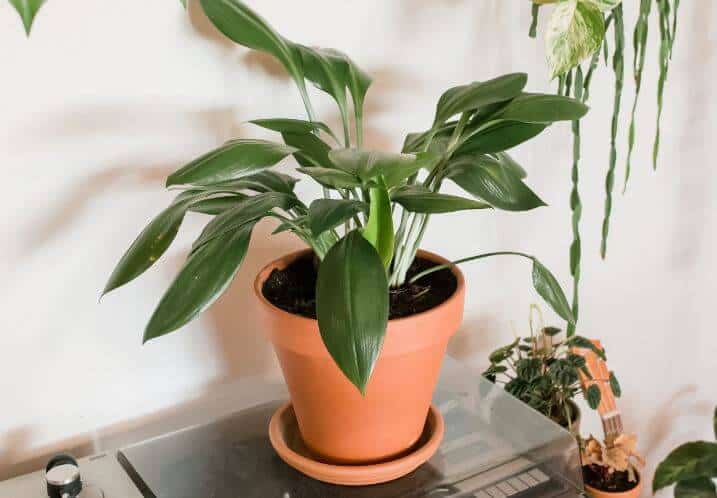Last Updated on June 2, 2023 by a Friendly Gardener
Botanically named Aspidistra elatior, has a reputation as an indestructible house plant. Commonly known as the Cast Iron plant, this hardy plant can tolerate environmental conditions that would kill many other houseplants and survive forgetfulness and neglect.
A herbaceous perennial, it boasts impressive deep forest green leaves, shaped like lances topping off long arching stems. Foliage can grow as long as two feet and as wide as four inches. This plant can be successfully cultivated outdoors in certain areas and will produce purple-hued blooms at the base of the plant. The Cast Iron plant grows quite slowly.
This plant’s natural habitat can be found in Asia, and it is a member of the Liliaceae family. Popularly known also as the “Bar Room Plant” and the “Ballroom plant”.
Cast Iron Plant Care

For beginner gardeners or those without a green thumb, the Cast Iron plant may open the door for you to indoor home gardening. This plant is a survivor. It is able not only to survive but to thrive where other plants cannot. Low light conditions and heavy shade are not a deterrent for the Iron Cast plant and disease and pest infestations are less of a challenge than with other species.
The Cast Iron plant is a generous plant that asks little of its owner. Occasional feeding during the growing season and watering when the soil dries are sufficient. Overwatering and soggy soil should be avoided soggy soil together with exposure to direct sunlight. These plants are independent and will reward you with lustrous foliage.
Soil
The Cast iron plant will do well in a variety of soil types if they are well-draining. Ideally, the soil should be rich organically with a slightly acidic pH level measured in the 4.5 to 7.0 range.
Outdoors, this plant can be planted in loamy, sandy, and clay soils. For clay soil, blend in peat moss or composted manure to aid in water absorption. Clay soil must be broken up when tilled and mixed with peat or compost. Mulch can aid with water retention as well as prevent weeds from taking root. Indoor cultivation will do well in quality potting mix if the plant’s container has a sufficient number of drainage holes.
Light

The Cast iron plant should not be exposed to direct sunlight to avoid scorching or burning its foliage. Locate your plant near a window but do not place it directly in the window to avoid direct sunlight exposure. When cultivating these plants outside, plant them in an area of your garden that affords partial shade with bright however indirect sunlight.
Water and Humidity
The Cast Iron plant will tolerate drought but will prefer a soil bed that is capable of retaining moderate moisture. Younger plants can be watered on a regular schedule to maintain soil moisture. Avoid leaving your plant standing in soggy soil. Soggy or water-logged soil will lead to root rot and can prove to be lethal to your plant. Mature plants should be watered thoroughly. Allow at least two inches deep of the soil bed to dry out before watering again. Poke the soil bed with your finger. If there is no dampness, it’s time to water.
The Cast Iron plant will thrive in an environment with moderate humidity so normal home humidity levels should be more than adequate.
Temperature
Ideally, your Cast iron plant’s preferred temperature should measure in the 60° to 75° Fahrenheit range. These plants do not appreciate cold. If environmental temperatures drop to below 50° F, they can be harmed and eventually fail. Cast Iron plants cultivated indoors in containers can be placed on porches, patios, balconies, or decks, but make sure to move your plant inside before the first frost arrives.
Feeding
Feed your Cast Iron plant monthly in the growing season during spring and summer with a quality liquid fertilizer. In the fall and winter, they do not need to be fed. Dilute liquid fertilizer to half strength and apply it after you have watered the plant to avoid burning the plant’s roots during feeding.
Pruning
The Cast Iron plant is pruned primarily for aesthetic purposes. It may also be trimmed to remove pests. Remove any dead foliage you find on your plant. Leaves that exhibit insect damage can also be pruned away. Use sterilized scissors or gardening shears when pruning any houseplant to avoid the transference of disease or bacteria from one plant to another.
Repotting

Cast iron plants must have pots with a sufficient number of good drainage holes. The ideal pot should measure a tad larger than the plant’s actual root ball size. Because Cast Iron plants are slow-growing plants, they do not generally outgrow their pots very quickly.
If you notice roots peeking out of the draining holes or soil bed, it is time to repot. Do not expect this to happen every year, but expect it to do so every several years, perhaps as many as five years. For peace of mind, repot every two or three years in the spring. Remove the plant gently from its original pot and transfer it to a new container with fresh soil.
Cast Iron Plant Propagation

To propagate your Cast Iron plant, the easiest method is through division. To create a new cast iron plant, remove a piece plant’s rhizome or underground stem. This section should have at least two leaves growing on it. Put the stem piece in a new pot with fresh soil, or your garden bed outside.
The new pot and soil should remain slightly dampened to stimulate rooting. Nonetheless, the soil and pot should be well-draining. Do not place the new plant in direct sunlight but keep it in a warm location. When new shoots emerge, the new plant will have developed a root system and can be cared for as a settled plant.
Toxicity and Pets
The ASPCA or American Society for the Prevention of Cruelty to Animals informs us that this plant is non-toxic to cats, dogs, and even horses, so it is a perfect houseplant for homes with pet family members or outdoor locations with stables.
Pests, Diseases, and Problems

While a Cast Iron plant is not particularly vulnerable to pest infestations, several typical houseplant bugs may decide to disturb your plant. Spider Mites, Mealybugs, and Scale are all potential visitors that need to be eliminated rapidly. A treatment with insecticidal soap or organic Neem oil is recommended.
This plant is somewhat vulnerable to leaf spot diseases and root rot from overwatering. Leaf spot diseases are caused by a fungal infection known as Fusarium. Fusarium will destroy the rhizome roots underneath the soil. Leaves will gradually appear spotted, with the spots appearing water-soaked. These spots eventually turn reddish-brown. The spots, in turn, produce spores that continue to reproduce and spread. Leaf blight is a serious problem. Remove spotted leaves and apply an organic fungicide such as Neem oil and try to keep leaves dry when watering.
Sclerotia rolfii, called Southern blight is another potential problem. The stems of your Cast Iron plant will feature brown lesions. When left unresolved, leaves become yellow and wilt. The formation of white mycelium on a plant is also characteristic of this disease. This fungal infection typically spreads in soggy or water-logged soil. Apply a copper-based fungicide to the plant and avoid overwatering.
Brown leaf tips usually signal a watering problem. When a plant is overwatered, it will cause the plant to release excess water from the leaf tips. They then become brown. Underwatering can also be indicated by brown leaf tips. Soil needs to remain evenly dampened.
In Conclusion
The Cast Iron Plant has earned its name because it is very similar to cast iron as it is literally indestructible. If you provide it with minimum care and the proper environmental conditions, it will be a lovely addition to any location. It is a wonderful choice for beginner home gardeners or for those that feel they don’t have a green thumb or luck with houseplants.

